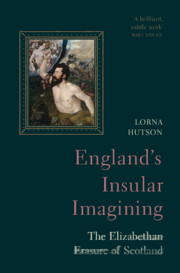Book contents
- England’s Insular Imagining
- England’s Insular Imagining
- Copyright page
- Contents
- Plates
- Abbreviations
- Acknowledgements
- Introduction
- Chapter 1 Writing the Forgotten War I: Henry’s War, 1542–1547
- Chapter 2 Writing the Forgotten War II: Somerset’s War, 1547–1550
- Chapter 3 How England Became an Island: The Faerie Queene
- Chapter 4 Scotland sui juris? Scottish Literature and the Marian Constitutional Crisis, 1567–1573
- Chapter 5 On the Knees of the Body Politic: Scottish Succession and English Liberties, 1567–1608
- Chapter 6 Scotland Un-kingdomed: English History on Stage
- Chapter 7 Race-Making in the Invention of Britain: The Masque of Blackness
- Chapter 8 Divisions and Kingdoms: Oedipal Britain from Gorboduc to King Lear
- Coda: Macbeth. ‘Alas, poor country’
- Works Cited
- Index
- Plate Section (PDF Only)
Chapter 8 - Divisions and Kingdoms: Oedipal Britain from Gorboduc to King Lear
Published online by Cambridge University Press: 28 September 2023
- England’s Insular Imagining
- England’s Insular Imagining
- Copyright page
- Contents
- Plates
- Abbreviations
- Acknowledgements
- Introduction
- Chapter 1 Writing the Forgotten War I: Henry’s War, 1542–1547
- Chapter 2 Writing the Forgotten War II: Somerset’s War, 1547–1550
- Chapter 3 How England Became an Island: The Faerie Queene
- Chapter 4 Scotland sui juris? Scottish Literature and the Marian Constitutional Crisis, 1567–1573
- Chapter 5 On the Knees of the Body Politic: Scottish Succession and English Liberties, 1567–1608
- Chapter 6 Scotland Un-kingdomed: English History on Stage
- Chapter 7 Race-Making in the Invention of Britain: The Masque of Blackness
- Chapter 8 Divisions and Kingdoms: Oedipal Britain from Gorboduc to King Lear
- Coda: Macbeth. ‘Alas, poor country’
- Works Cited
- Index
- Plate Section (PDF Only)
Summary
To read Lear as connected to Union debates is not reductively topical: the story of Leir belongs to the Galfridian history on which England’s British claims were founded. Moreover, as a Senecan Oedipal tragedy, Shakespeare’s Lear responds to the ‘Oedipal Britain’ found in Elizabethan tragedies such as Gorboduc, Jocasta and The Misfortunes of Arthur. These are national tragedies that lament the natio/nation as lost place of origin, a mother destroyed by her children. Shakespeare’s Lear resists this identification. In Shakespeare’s Lear, the ostentatiously childless deaths of Goneril and Regan destroy the Galfridian prophetic future, while the doubling of Oedipus and Antigone in Lear/Cordelia and Gloucester/Edgar thoroughly ironises and makes impossible any tragic identification of nation and maternal birthplace. In consigning the futureless ‘state’ to Albany and Edgar, icons, respectively, of Scottish enmity and English sea-sovereignty, Shakespeare compounds the tragedy’s ironic relation to contemporary naturalisation debates.
- Type
- Chapter
- Information
- England's Insular ImaginingThe Elizabethan Erasure of Scotland, pp. 245 - 278Publisher: Cambridge University PressPrint publication year: 2023

